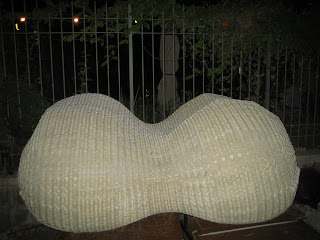6/06/2009
6/05/2009
Enhancement Surgery




In our last post, we explained that we were going to try and see how large a span we could create with our existing technology. We called in the best plastic surgeons and ended up with some Pamela Anderson sized curves, which were just barely sturdy.
Inside, the structure was quite warm and snugly, actually it was surprisingly pleasant. But seeing as how we had maxed out the spanning capability of the structure, and could not think of another trick to increase its spanning capacity in pure tension, we were faced with a choice between two options: 1) Limit the size of our structure to slightly smaller that what is shown above, create three separate pods, and connect them together. OR 2) introduce another structural element, which could assist us increasing the span. We decided that due to our limited supply of egg crates and a desire to make a substantial inside space rather than a cocoon, that we would do the latter.
We decided that we would try to do as minimal a change as possible. In our structure, the wires had previously acted entirely in tension. Some of them were even completely flexible, ie they had no compressional strength. We kept the basic form, changing it to create a large space for the two girls and smaller space for the one boy. We analyzed the form and decided that if three of the wires could also act in compression, we would be able to greatly increase the span. Therefore, we are widening the pod from 9 columns to 10, reconfiguring it to make these two separate but attached spaces - a low, narrow space and a high, wide space - and introducing three stronger wires.
Below is the new scheme, as compared to the old one.

Inside, the structure was quite warm and snugly, actually it was surprisingly pleasant. But seeing as how we had maxed out the spanning capability of the structure, and could not think of another trick to increase its spanning capacity in pure tension, we were faced with a choice between two options: 1) Limit the size of our structure to slightly smaller that what is shown above, create three separate pods, and connect them together. OR 2) introduce another structural element, which could assist us increasing the span. We decided that due to our limited supply of egg crates and a desire to make a substantial inside space rather than a cocoon, that we would do the latter.
We decided that we would try to do as minimal a change as possible. In our structure, the wires had previously acted entirely in tension. Some of them were even completely flexible, ie they had no compressional strength. We kept the basic form, changing it to create a large space for the two girls and smaller space for the one boy. We analyzed the form and decided that if three of the wires could also act in compression, we would be able to greatly increase the span. Therefore, we are widening the pod from 9 columns to 10, reconfiguring it to make these two separate but attached spaces - a low, narrow space and a high, wide space - and introducing three stronger wires.
Below is the new scheme, as compared to the old one.

6/04/2009

Sleeping under cardboard boxes is a longtime cliche behavior of persons without a home. So it is comedic, controversial or artistic to render this default choice a conscious design strategy? Whatever your opinion, these designs are remarkably lifelike from a distance - making even the most elegant bed appear to be covered in recycled and tattered cardboard scraps thrown together.
Inspired by a Homeless Cardboard Box
Ever slept under a cardboard box? Probably not. There is a unique project launched in the form of duvet covers by Le Clochard. When I first saw these pictures I wasn’t sure whether the bedding was made out or real carton or cotton, but after I’ve read a little about this project I’ve found that they are made out soft 100% cotton and you can really sleep under it. The Le Clochard Project by SZN hopes to help young homeless people in the Netherlands. A large portion of the proceeds from the sale of the quilt cover and the pillow cases goes towards helping young folks in the Netherlands find work or continue education.
by Le Clochard. When I first saw these pictures I wasn’t sure whether the bedding was made out or real carton or cotton, but after I’ve read a little about this project I’ve found that they are made out soft 100% cotton and you can really sleep under it. The Le Clochard Project by SZN hopes to help young homeless people in the Netherlands. A large portion of the proceeds from the sale of the quilt cover and the pillow cases goes towards helping young folks in the Netherlands find work or continue education.



Subscribe to:
Posts (Atom)



